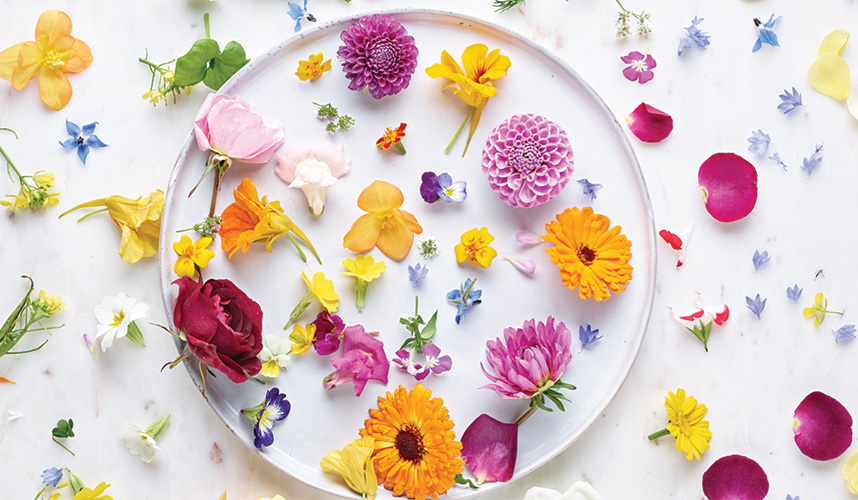You will probably know the delicate tastes of courgette flowers and peppery nasturtiums, and sweet violet, lavender and rose petals, but you can also eat geraniums, fuchsias, pansies, peonies and carnation (eat the petals only). Their taste is generally citrusy or very mildly spicy, but it’s not really about the flavour – it’s about the delicate beauty and wonder they can bring to a dish – turning the everyday into a fairytale feast.
Take a walk into the countryside to forage for more floral ingredients. Elderflowers, of course, make delicious cordials, cakes and fritters, but there are lesser-known blooms that are equally useful in the kitchen; hunt for mallow, daisies, dandelions, dead nettles and wild mustard.
Ensure that the flowers you pick haven’t been sprayed with pesticide, don’t eat them if you have asthma or hay fever, and make sure the blooms are at their peak; not budding or wilting. Remove the stamens and pistils before eating - the pollen can make the flowers taste unpleasant – and avoid eating flowers’ leaves – not all of them are as safe as the blooms. Always check online or in a book that what you’ve collected is safe to eat.
MORE READING
Edible Flower Garden by Rosaline Creasy (Periplus Editions)
The Garden Forager by Adele Nozedar (Square Peg)
BLOOMING TASTY - Buddy brilliant flowery food ideas
TEA - Any edible flower can be used to make tea, you’ll need one tablespoon for every cup. The easiest method is to put fresh whole petals into a tea ball or wrap them in muslin, then steep them in boiling water. Or dry them out to use all year. Try rose, anise, chamomile, lavender, marigold or hibiscus.
SALADS - Edible flowers make your salads look magical. Try scattering chive flowers in potato salad, snap-dragons and violas with carrots, radishes and leaves, or peppery nasturtium leaves in green salads. Don’t use heavy dressings; they’ll make your beautiful creations wilt.
TEMPURA - Lightly battered and fried flowers make a stunning and tasty summer lunch – be sure to eat them immediately. Try courgette flowers, or calendula blooms served with a honey and vinegar dip. Elderflower fritters are aromatic and delicate - use the thinnest of batters and serve with a tart gooseberry purée.
ICE CUBES - Freeze edible flowers in ice cubes to make long summer cocktails the height of elegance, or scatter some into your home-made ice-lollies – we like apple, anise or cornabria blossom in ours.
CANDIED PETALS - Try preserving violet, rose, scented geraniums, lilacs, borage or pansies. Paint them with egg white, then sprinkle them with caster sugar and allow to dry before storing in airtight containers. They’ll keep for up to a year, brightening and adding summery colour to dull winter dishes.
CAKES - Flowery cakes are the stuff of lazy, sunny daydreams; afternoon tea, church fetes, riverside pic-nics. Try adding lilac blossoms and almonds to a scone recipe, lavender to shortbread, or elder-flower to a sponge. Edible flowers such as pansies or roses make an ordinary chocolate cake into a stunning, summery celebration.







